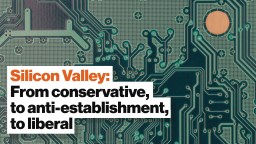MARGARET O'MARA:The first part of the 20th century, Silicon Valley wasn't known as Silicon Valley. It was the Santa Clara Valley. It was a agricultural region. It was best known for being the prune capital of America. It was where the fruit was grown, and canned, and harvested. So it really was off to the side of the main action. Where the real turning point for the Valley was the 1940s, World War II. It was the turning point for California and the Pacific West. The Pacific Theater brought thousands of servicemen streaming through ports like San Francisco. It built up the military installations up and down the San Francisco Bay Area, as well as up and down the West Coast. And then after the war, this continued with the Cold War and a great deal of military activity.
California getting a huge amount of this spending, of military spending, that Dwight Eisenhower later memorably labeled the military-industrial complex. And California was one of its capitals. So in the middle of all this is this little university, Stanford, which had been founded in the 1890s by a railroad baron and his wife. Stanford is an unusual place. Unlike the colleges of the Ivy League, which were founded in colonial times to educate future clergymen and lawyers-- kind of liberal arts institutions, Stanford was started with a very practical mission in mind. In its founding grant it says, to the effect, "Bring something useful into the world." And so Stanford always had a technical bent. The sciences and engineering were always a focus.
And as the government kind of ramped up this unprecedented spending on engineering, on science as America entered the nuclear age, the leaders of Stanford, notably its dean of engineering, an electrical engineer named Fred Terman, recognized there was, as Terman put it, a wonderful opportunity that Stanford could take advantage of. Terman had spent World War II in Boston. He was working for the government. Working as part of the many, many thousands of academics, scientists, and engineers who had gone to work for the Office of Wartime Research and Development, which was run by Terman's graduate mentor from MIT, a guy named Vinnie [? Verbush. ?] and Terman realized that everything was going to change for the sciences, that there was this big opportunity. And for Stanford, a place where he had grown up-- he was a faculty kid. His father had been a professor there, too. Palo Alto was home. He wrote to a friend during the war, "Stanford has this opportunity to become like Harvard, if we take advantage of this.
Or it could just kind of be a place like Dartmouth, which is respected, but not important to the national conversation." I don't know how people at Dartmouth would feel about that, but he was being a little-- there was a little bit snark there. So Terman comes back. And partnering with the then-president of the university, Wallace Sterling, who was a historian, I like to always add, they really remade Stanford's whole curriculum to beef up the physics department to create whole programs that were designed to work with industry, with these new defense industries that are growing up in California and in the Bay Area. And to really tailor programs so that they are training undergraduates and graduates in the sciences and engineering to go out and go into this work of these new electronics companies that are booming in this post-war period. It was something that no other university has done really, before or since. And that's one thing that set the Valley apart. The invention that transformed the Valley was not invented in the Valley. It was invented in Bell Laboratories, New Jersey-- The transistor, 1947.
And one of its co-inventors was a guy named William Shockley, who happened To be from Palo Alto, originally. And so when he leaves Bell Labs and decides he wants to start up a company of his own, That's producing and marketing silicon semiconductor technology based on this transistor, this breakthrough transistor. He decides to go to Palo Alto. He is persuaded in part by his friend and fellow Palo Altan, Dean Fred Terman Of Stanford, who said come out here. But also, his mother was still in-- Shockley's mother was still in Palo Alto. She was ailing. And he was a mama's boy and wanted to come home. So that choice proved to be momentous, because Shockley was a Nobel Prize-winner. His move to Palo Alto really made everyone sit up and take notice. And he hired some of the brightest engineers he could find. Recruited them to come out and work for his new Shockley Semiconductor Lab, 1955 56. And off to the races. But, plot twist, Shockley turned out to be world's worst boss. He was terrible to work for. He was imperious.
There was a reason that none of his team from Bell Labs Came with him to Shockley Semiconductor. As the new recruits quickly found out, this was not a good place to work. Shockley, later in his life, actually, in his later stage of his life is marked by an embrace of eugenics, scientific racism. Shockley was a very complicated and flawed character. But the immediate effect was Shockley recruited these amazing engineers To come out to develop this silicon semiconductor technology. And within a few years, those engineers had decided they were going to quit And they were going to form a rival company of their own. And those eight men, who became famously known as the Traitorous Eight, Left Shockley and started a company called Fairchild Semiconductor, Getting venture backing from an East Coast industrialist. Funnily enough, it was a son-- A guy named Sherman Fairchild, Fairchild was able to invest in Fairchild Semiconductor or create Fairchild Semiconductor, because he had inherited a lot of money from IBM stock.
So funnily enough, IBM is sort of granddaddy of all computer companies. Helped indirectly fund the first, the iconic grandfather of all these Silicon Valley startups. A semiconductor industry that in turn would give way to a personal computer industry that would displace IBM atop the computer heap. So there's a wonderful circular story, here. So Fairchild Semiconductor is incorporated in September, 1957. What happens two and 1/2 weeks later? Sputnik satellite shoots off into space. And so the Space Race, that race, was part of what sent Silicon Valley's rocket ship off the launchpad, so to speak. Because what it created was an intensified demand for very small and light electronics, which is what the Valley specialized in. Think about the West Coast. You had a number of hubs of defense-related industry.
You had my town, Seattle, aerospace town, building big planes, building big things. Down in LA, also building airplanes, building big things. In the Valley, they built small. And the Space Race creates intensifies the demand for small computational and communications devices that the Valley specialized in. So these early chip makers, even though they grow large, grow wealthy with private sector customers and their private businesses, at the very beginning, a company like Fairchild, for example, in the very early years got 80 percent of its book of business from the Defense Department and from government agencies, including NASA. The government was an extremely important customer. It was very deep-pocketed. It was willing to spend a lot of money on blue sky technology for which there was not yet a market.
And it kind of created the safe foundation for a competitive private sector entrepreneurial startup culture to start. It's really funny, the biggest of big government programs helped Silicon Valley, the startup world, get its start. And that's the alchemy. It isn't just big government and it isn't just free market entrepreneurship. It's this blend of both that comes together in the Valley at this particular time and place. And starts generating generation after generation of companies. OK. So many places have tried to become Silicon Valley. We have silicon everything's around the world. And so why is Silicon Valley still reigning supreme? Well, you really can't make another one because it's a product of a distinctive time and place. It also is the product of seven decades of multiple tech generations building on one another. One of the secret ingredients of Silicon Valley is time.
Now, this doesn't mean that other places around the world can't build vibrant, high-tech regions. There are plenty places around the world that are growing hubs of innovative industry, of creative industry, of tech-based industry. But the Silicon Valley magic was something that was very much a product of post-war America, of the way that-- the geopolitical conditions, the nature and the lack of meaningful overseas competition for a while. I mean, one of the reasons that the American economy and American industry grew to become so dominant in the 25 years after World War II is because the rest of the industrial world left World War II literally in ruins. And when those economies, like Germany and Japan, get themselves rebuilt, and rebuilt in even better ways, that's when they start becoming serious competition to American industry.





